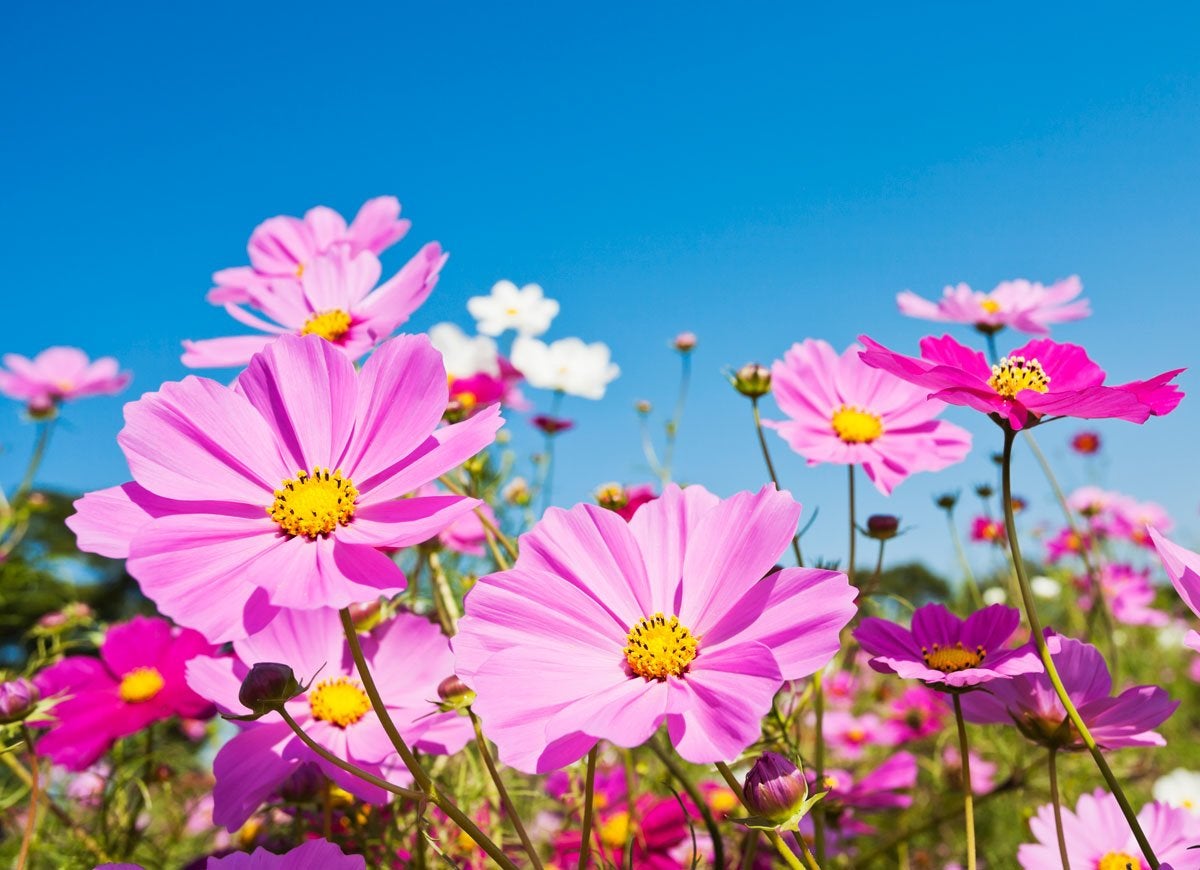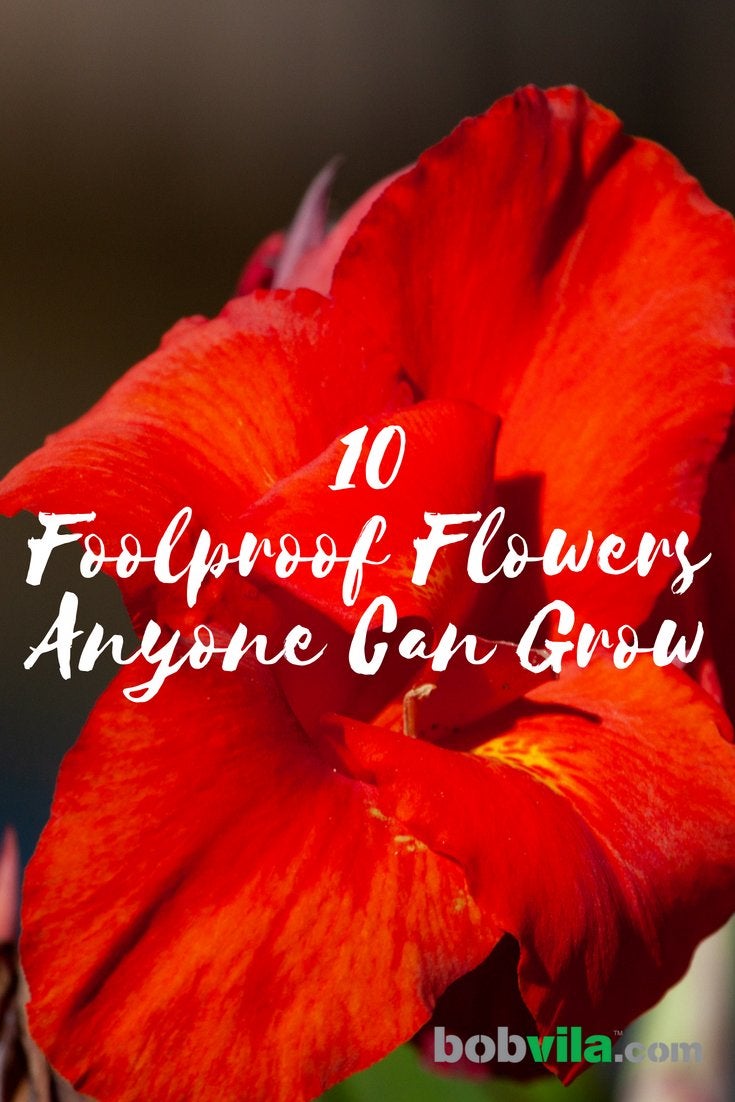

We may earn revenue from the products available on this page and participate in affiliate programs. Learn More ›
Home Advice You Can Trust
Tips, tricks & ideas for a better home and yard, delivered to your inbox daily.
By signing up you agree to our Terms of Service and Privacy Policy.
Cosmos

A dainty flower with a slender stem, cosmos stand up against heat, drought, and poor soil conditions. Gardeners don’t need to give cosmos much attention after sowing seeds. As long as you deadhead the blooms, avoid overwatering, and stake if necessary, they’ll survive until frost hits the ground in autumn. What’s more, cosmos – which usually have rosy, white, or orange-colored petals– experience relatively few problems with pests, and they also self seed. Available on Amazon; $3.65 for 400 seeds.
Daffodils

Characterized by their six trumpet-shaped petals in hues of white or yellow, daffodils are surprisingly easy to grow. Gardeners plant daffodil bulbs in the fall, then ignore the flowers until they bloom in late winter or early spring. Once bloomed, they still call for little maintenance. Simply supply full sun, slightly acidic well-draining soil, and sufficient water. With the right conditions, long-living daffodils will come back year after year! Available on Amazon; $39.99 for 50 bulbs.
Yarrow

For a bare plot of garden in a sunny yard, there are few plants that are as low-maintenance as yarrow. These perennials are drought-tolerant, grow in almost any soil type, and need little in the way of fertilizer. Yarrow, which comes in more than 80 varieties, will bloom repeatedly throughout the season—and all you need to do is deadhead spent flowers. Available on burpee.com; $26.95 for 4 plants.
Zinnia

Fast-growing zinnia is a good choice for any gardener who gets a late start on planting flowers by seed. Zinnias lure pollinators to your garden from the time they bloom until they disappear with the first frost. Although they’re susceptible to fungal diseases when overwatered, they can stand up to hungry deer, who won’t go near the fragrant flowers. Available on burpee.com; $4.95 for 50 seeds.
Aster

This self-sufficient perennial needs no gardener to keep it looking cheery—its starry, petal-packed flowers reappear with little prodding year after year! Get ready for a palette of purples and pinks that bloom from late summer/early fall to the first frost. Not only will aster brighten the landscape long after most of its neighboring flowers fade, but they also invite gold-winged Monarch butterflies to flock to your garden for food. Available at Home Depot; $19.49 for a 1-gallon plant.
Red Leaf Begonia

flickr.com via Katrina J Houdek
While most begonias thrive in shade, the red leaf variety can tolerate sunlight, too. Its waxy beet-colored leaves and pink- or white-hued buds show up all summer long in both humid or arid conditions, making it the most amiable option for the average yard. Just putting down roots for your garden? Plant these begonias in a bed or box on the north or east side of your home beneath a large tree or covered patio, since this location will create a happy compromise of filtered sunlight. Feed red-leaf begonia every other week for nonstop blooms in the summertime. Available at Amazon; $4.99 for a 4-inch plant.
Marigold

The easy-going marigold, which blooms is bold oranges and yellows, is a bright addition to any garden. Perhaps the best part about marigold is its carefree nature. The flowers thrive under the sun, but they also don’t mind a bit of mid-afternoon shade. Marigold also isn’t finicky about soil types. What’s more, the flowers are beneficial to your garden: marigolds release thiophenes into the soil from their root systems, killing nematodes that cause root-knot. Available on
Amazon
; $5.69 for 1,000 seeds.
Sunflower

It goes without saying that the sunflower loves the sun. Each day, the golden flowers turn their large heads to face the direction of the sunlight. The cheerful sunflower is also surprisingly easy to grow. It isn’t particular about a soil type, and while it prospers from getting plenty of water, it can tolerate periods of heat and drought. Sunflowers have coarse and tall stems that often reach several feet in height when exposed to at least six or eight hours of full sun each day. Expect sunflowers to bloom from the middle of summer through the fall. Available on
Amazon
; $7.95 for 200 seeds.
Echinacea

You may know Echinacea as an immune system-boosting herbal supplement, but for veteran gardeners, it’s a tough yet lovely perennial that demands little in exchange for its eye-catching, daisy-like blooms. Native to the prairies and open woods of the Midwest, Echinacea stands up well not only to cold snaps and destructive garden insects, but also to periods of extended drought. Meaning, if you forget to water for a couple weeks during a dry summer, the cone-shaped, pink-petaled blooms continue to look as show-stopping as ever. In fact, though Echinacea blooms for much of the year—from early summer to the first frost of winter—it remains a beautiful border plant even once its flowers fall. Available at Amazon; $4.79 for 250 seeds.
Lavender

Beloved for its vibrant purple flowers and fresh, calming fragrance, lavender favors hot, dry conditions akin to those of its native region, the Mediterranean. That being the case, for stateside gardeners (zones 5 to 9), there are two simple keys to success. One, be sure to plant the perennial in a spot that receives at least six hours of direct sun daily. Two, don’t overwater. Give lavender a long, thorough soak, but only when the soil feels almost dry to the touch (once a week or twice a month, weather depending). Experts also recommend pruning in the spring, soon after the first flowers, in order to encourage new growth and help the plant keep its trademark shape. Available at Amazon; $5.69 for 5,000 seeds.
Infallible Flowers

With these low-maintenance flowers, you can get a pretty garden without all the work.

I Was Dead Set On Stone Floors—Until I Saw These Options
See how a virtual floor designer might just change how you envision your floors, as it did for this editor with her ongoing kitchen renovation.